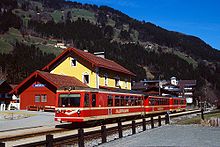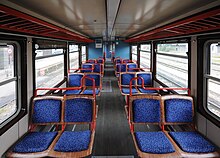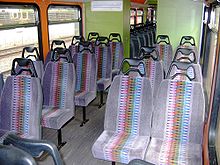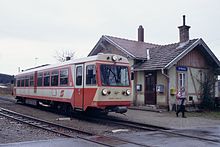StB VT 31-35
| StB VT 31-35 ÖBB 5090 |
|
|---|---|
|
VT 33 of the tax office in Tamsweg
|
|
| Numbering: | StB VT 31–35 ÖBB 5090 001–017 ZB VT 3–8 SLB VTs 11–16 NÖVOG 5090 007–017 Döllnitzbahn VT 137 515 |
| Number: | StB: 5 ÖBB: 17 (2008: thereof 6 to SLB) ZB: 6 SLB: 6 (from ÖBB) NÖVOG: 10 (from ÖBB) Döllnitzbahn: 1 (from NÖVOG) |
| Manufacturer: | Stahlbau Knotz, Vienna Bombardier Jenbacher Werke ; electrical: FIG |
| Year of construction (s): | 1981-1999 |
| Axis formula : | B'B ' |
| Genre : | Diesel railcars |
| Gauge : | 760 mm / 750 mm (Döllnitzbahn) |
| Length over coupling: | 17,730 mm (VT 31–34) 18,300 mm (ÖBB 5090) |
| Height: | 3565 mm |
| Width: | 2424 mm |
| Trunnion Distance: | 10,030 mm (VT 31–34) 10,300 (ÖBB 5090) |
| Bogie axle base: | 1700 mm (VT 31–34) 1,830 mm (ÖBB 5090) |
| Total wheelbase: | 12,130 mm |
| Service mass: | 29 t |
| Top speed: | 70 km / h |
| Continuous output : | 235 kW |
| Starting tractive effort: | 82 kN |
| Continuous tensile force: | 26.5 kN |
| Driving wheel diameter: | 700 mm |
| Fuel supply: | 300 l diesel |
| Motor type: | MAN six-cylinder |
| Motor type: | Diesel engine |
| Rated speed: | 2100 rpm |
| Power system : | Alternator / DC motor |
| Power transmission: | Bridge rectifier |
| Number of traction motors: | 2 direct current series connection |
| Drive: | diesel-electric |
| Brake: | electrical resistance brake , indirectly acting compressed air brake |
| Train heating: | Webasto |
| Coupling type: | Scharfenberg coupling |
| Seats: | 64 |
| Standing room: | 36 |
The locomotives VT 31–35 of the Steiermarkbahn and Bus are narrow-gauge diesel railcars with a track width of 760 mm , which were designed for the Murtalbahn and are used on it. Based on this type of vehicle, the railcars of the 5090 series of the ÖBB and a series of railcars of the Zillertalbahn were developed.
VT of the Steiermarkbahn
From around 1968, as part of the modernization of the Murtalbahn, new diesel locomotives were procured, which pushed the steam locomotives , mainly U series locomotives , into the reserve and to the tourist trains introduced around the same time. However, since only three of the powerful locomotives from the VL 11-16 series were available, most services were provided as passenger trains with goods transport . This form of operation was associated with the disadvantage of longer travel times due to the shunting work in the subway stations; a separation of passenger and freight traffic was not feasible due to the small number of locomotives. When, towards the end of the 1970s, the replacement of passenger transport by buses was already being discussed, the management of the state railways decided on an alternative solution on the rails, which led to the development of a railcar with diesel-electric power transmission . The Viennese company Knotz, which at that time was known for the production of individual constructions in rail vehicle construction, also in small numbers, received the order for the production.
In November 1980 the first VT 31 multiple unit was transferred from the manufacturer's plant in Vienna to the Murtalbahn. After test drives and staff training, the railcar was first used in public transport in February 1981. A further three railcars were delivered by the summer and used as planned from the change in the timetable. Although the railcars were basically designed for one-man operation (the driver is also responsible for selling tickets), the StLB procured four matching control cars (VS 41-44) and a mail car (DF 93). These vehicles were delivered during 1982.
According to their area of use as local trains and also for weight reasons, the vehicles are set up quite sparingly, which is noticeable, for example, when the toilet is omitted, only the control cars have one instead of the second driver's cab. Furthermore, tram-like folding revolving doors, non-opening windows with ventilation flaps and compressed wood seats were installed. There are small storage spaces for luggage next to the entrances; in addition, two of the 64 seats at one end of the car can be opened. The vehicles have an automatic Scharfenberg coupling , which also couples the air lines of the brake system, while the electrical connections have to be made via a separate cable that can be connected manually. Another difference to the other narrow-gauge vehicles, which are braked with suction air in Austria, is the compressed air brake (there is also an electrical resistance brake). A combination with these is therefore not possible, only the mail car has adapter couplings and both brake systems.
All vehicles were originally painted yellow with orange-red fronts and a blue roof, in 1995 they were given their current colors in red, white and green. In the course of revisions in the 1990s, they were also fitted as a replacement for the now worn original engines of the type that was used in the 5090 series of the ÖBB. The vehicles were also equipped with more comfortable upholstered seats.
Today, the vehicles are usually used in a combination of multiple units and control cars as two-car trains; the VT 35, which was subsequently procured from the Jenbacher works in 1999 , was initially only used as an amplifier car in the school trains due to numerous deviations from the first series. Only after extensive adjustments to the older vehicles can it be used freely. The mail car was parked after the rail mail was stopped on the Murtalbahn in 1998.
On December 10, 2002, a freight and passenger train collided head-on on the Murtalbahn. The locomotives involved were the VL 12 diesel locomotive and the VT 34 railcar with the VS 41 pushed control car. The railcar was only slightly damaged. During the repairs, the damaged railcar end was designed in the same way as the new VT 35 railcar. In the case of the heavily damaged VS 41 control car, on the other hand, only the head and rear section were initially completed using steel construction, painting and finishing were not completed for financial reasons and due to a lack of spare parts. In the meantime, the VS 41 has been sold to the Moldovița Forest Railway , where it has been converted into a carriage with open platforms.
On January 14, 2019, the VT 32 caught fire in Murau station and was significantly damaged in the process. The 150 passengers on the train were rescued unharmed.
Zillertalbahn railcar

In the summer of 1984, two technically almost identical railcars from the same manufacturer were delivered to the Zillertalbahn , which were given the numbers VT 3 and 4. However, they only have one driver's cab and were therefore initially used with the control cars that were procured at the same time and also with one or two intermediate cars. For the planned increase in the maximum line speed at the beginning of the 1990s, the multiple units in this configuration did not have the necessary acceleration capacity. A control car (VS4) and an intermediate car (BD4 42) were sold to the Pinzgauer Lokalbahn on August 1, 2018.
For this reason, the Zillertaler Verkehrsbetriebe initially acquired two further VT 5 and 6 multiple units in 1992, which differed from the first delivery in terms of soundproofing panels and transfer windows and which replaced the control cars, especially in four-part trains. These vehicles were built by Jenbacher Transportsysteme . With one of the two control cars and some intermediate cars, a push-pull train was formed, which is pulled or pushed by a suitably equipped diesel locomotive and supplements the multiple units.
Finally, in 1998 two more railcars VT 7 and 8 were delivered, which, like the VT 5 and 6, come from Jenbacher. Today the railcars are preferably used with an intermediate car as three-car trains, usually a vehicle of the latest generation with a low-floor section is used in order to be able to offer at least one barrier-free entry into the train .
Railcar 5090 of the ÖBB



In the early 1980s, the narrow-gauge railways of the ÖBB were served exclusively by older-style locomotives and passenger coaches, and the trend was towards the closure of branch lines. The Steyrtalbahn and the Bregenzerwaldbahn were discontinued in these years. On the remaining routes, however, the decision was made in favor of competitive passenger transport with modern vehicles. Since the railcars on the Murtalbahn were a complete success, the ÖBB finally rented the VT 34 and carried out test drives on the Waldviertel narrow-gauge railways in July 1983 . Test drives on the Pinzgaubahn followed in October of the same year . It turned out that these vehicles were also suitable for the ÖBB narrow-gauge railways. Based on the knowledge gained, the Federal Railways initially decided to procure five of these railcars. They were given the series designation 5090 and technically did not differ significantly from their model, only the pivoting folding doors were replaced by pivoting doors with better sealing properties. In contrast to the hinged folding doors, however, these cross the vehicle boundary line when open . As a result, the space for walking along the vehicle could be somewhat restricted if it were necessary to leave it in the tunnel.
The railcars were delivered to the Gmünd train conveyor station, but the first three came to the Krimmlerbahn in Zell am See after testing , while the last two stayed in the Waldviertel, where they were used on the Gmünd - Groß Gerungs route from then on. Unlike the StLB, however, the ÖBB did not procure control cars or sidecars, the railcars should always be used solo.
While there was usually enough space in a railcar in the Waldviertel and both cars were only occasionally driven together, there were soon space problems in Pinzgau . In addition, it was still necessary there to drive with ÖBB 2095 and passenger cars. In order to be able to make this uneconomical operation more efficient, the two railcars 5090.006 and 007 were reordered, which arrived in St. Pölten for the first test drives at the end of 1991. In the same month they were transferred to the Pinzgau Railway, where from now on all passenger traffic could be covered with the five railcars. These two newly delivered railcars differed from the first series only in their paintwork (red / agate gray instead of blood orange / ivory), but they were built by Bombardier after the bankruptcy of Knotz . On the other hand, existing passenger cars were converted into sidecars and intermediate cars (compressed air brake, transition coupling, control line), which means that the maximum vehicle speed of the railcars can no longer be driven, as the old cars are only approved for 60 km / h. In principle, however, the Pinzgau Railway was the only narrow-gauge railway operated by the ÖBB, on which a maximum speed of 80 km / h was permitted in places.
In the mid-1990s, the 2091 series diesel locomotives still running on the “Krumpe” (the branch line of the Mariazellerbahn ) and on the Ybbstalbahn became topical. Therefore, a third series 5090 was procured, which differed considerably from its predecessors in terms of interior and exterior design, but were technically largely the same. Instead of the folding seats , two foldable longitudinal benches were arranged so that bicycles can also be transported. As a result, the 64 seats (still written down) are only of a theoretical nature.
Of the ten vehicles, which were all delivered in 1995, one came to the Pinzgau, six to the Ybbstal and only three to the Krumpe, which was enough given the meanwhile rather restricted traffic there. These three railcars stationed in St. Pölten were soon given the coats of arms of the neighboring communities.
After class 5090 railcars on the Mariazellerbahn even came to Mariazell on the occasion of test drives in the 1980s, their scheduled use under the contact wire began in early 1999, initially only to Kirchberg an der Pielach . In autumn 2001 the traffic to Laubenbachmühle was expanded.
Scheduled traffic on the Waldviertel narrow-gauge railways ended in summer 2001. While the locomotives and wagons for the tourist traffic that continued there remained in Gmünd, the two railcars 5090 004 and 005 were brought to St. Pölten, where they support the three existing railcars. From this point on, these were used to a greater extent under the catenary to Laubenbachmühle and also on the mountain route of the Mariazellerbahn to Mariazell. These railcars, together with the 4090 series, were to supplement and relieve the 1099 series electric locomotives, which will soon be 100 years old , until new vehicles are purchased .
With the takeover of the Pinzgauer Lokalbahn by the State of Salzburg, the railcars 5090 001 to 006 were handed over to Salzburg AG as its new operator, which now calls the vehicles VTs 11-16. By 2010 they were all painted in the colors of Salzburg AG (ruby red and white).
With the takeover of the last ÖBB narrow-gauge lines by the federal state of Lower Austria in December 2010, the railcars 5090.007-017 also changed hands and were transferred to NÖVOG's vehicle fleet . The numbers were not changed, only the control digits were removed. 5090.007 was awarded to Salzburg AG and designated as VTs 17. 5090.008, 009, 010, 013, 017 were based in Waidhofen / Ybbs at this time. The 5090.009, 010 and 017 were pasted in the Citybahn design (blue / yellow with tourist advertising motifs). 5090.011, 012, 014 and 016 were on the Mariazellerbahn. The vehicles are now listed under the designation "VT" with their serial number.
In 2012, Salzburg AG rented its VTs 11 multiple unit long-term to the Zillertalbahn, where it operates as the VT 1. On August 1, 2018, there was a vehicle exchange between the ZB and the PLB. The PLB's VTs 11 was sold to the Zillertalbahn. The PLB bought a control car (VS 4) and a Gmeinder diesel locomotive (D13) from the Zillertalbahn. PLB also acquired the BD4 42 from the Zillertalbahn, which has been operating on loan in Pinzgau since 2012. Both passenger cars were delivered to the Zillertalbahn together with the first railcars, the VT 3 and VT 4, in 1984.
VT 8 and 13 of the NÖVOG have meanwhile been transferred to Gmünd Lower Austria, where they are used in tourist traffic in the “Waldviertelbahndesign” (gold / light gray, with green “Waldviertelbahn” inscription). In 2015, the VT 16 was converted into a work car for the Mariazellerbahn.
Dollnitz Railway
In 2017, the VT 15 of NÖVOG was sold to the Saxon Döllnitzbahn . After re-gauging, general inspection and modernization and a new paint job in wine red with beige ribbon windows in the workshops of the Zillertalbahn, the railcar was sent to the Sächsisch-Oberlausitzer Eisenbahngesellschaft (SOEG) on September 20, 2018 for remaining work and for acceptance by the state representative for railway supervision in Saxony to Zittau ) transferred. On November 3rd and 4th, 2018, it was presented to the public on the diesel train between Zittau and the health resort Oybin. From November 2018 it will be used on the Döllnitzbahn together with the former Mariazeller passenger coach 3100 II in school traffic between Mügeln and Oschatz .
Individual evidence
- ↑ F. Haftel: New narrow-gauge railcars for the Murtalbahn . Railway Austria, 2/1981, s. 21-23
- ↑ Railway Austria 6/1982, p 117
- ^ Austrian Railway 1/1996, p. 23
- ^ The book of the Murtalbahn, pp. 96–97
- ↑ Schmalspur 3/2001, p. 9
- ↑ Schmalspur 1/2003, p. 7
- ↑ Forest Railway Moldovita - From the forest railway to a tourist attraction , page 56
- ^ Locomotive fire, Murau city fire brigade
- ↑ Railcar on the Pinzgauer Local Railway, currently 11/1983, Pospischil Verlag, Vienna
- ^ Eisenbahnverkehr aktuell 2/1992, Verlag Pospischil
- ↑ Schmalspur 3/2001, p. 5
- ↑ eisenbahn-magazin 1/2013, p. 83
- ↑ Döllnitzbahn railcars in Zittau arrived at www.doellnitzbahn.de on September 21, 2018, accessed on September 21, 2018
literature
- Günter Kettler: Diesel railcar of the ÖBB , Verlag bahnmedien.at, Vienna 2011, ISBN 978-3-9502648-7-6
- Erich Doleschal, Heinz Gerl, Helmut Petrovitsch, Wilhelm Saliger: Traction vehicles of Austrian railways - diesel locomotives and diesel multiple units , alba-Verlag, Düsseldorf, 1993, ISBN 3-87094-150-2
- Klaus Eckert / Torsten Berndt: Lexicon of the locomotives . Komet Verlag GmbH, Cologne, 2005, ISBN 3-89836-505-0
- Herbert Ortner: From the VT 31 to the 5090 - an Austrian narrow-gauge motor car family . Railway-Media-Group, Vienna 2010, ISBN 978-3-9503057-0-8
- Joseph O. Slezak, Hans Sternhart: Renaissance of the narrow-gauge railway in Austria . Slezak, Vienna 1986, ISBN 3-85416-097-6
- Steiermärkische Landesbahnen (Hrsg.): The book of the Murtalbahn . Self-published, 1994, ISBN 3-901474-02-1









